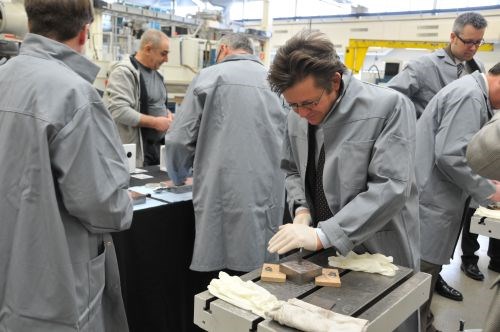An (Un)common Approach
Although differentiation is key to competitiveness, successful manufacturers seem to have a lot in common. Some of these shared principles were on full display during a recent tour of Studer’s plant in Switzerland.
Share


.png;maxWidth=45)
DMG MORI - Cincinnati
Featured Content
View More





Employees at Studer’s factory in Steffisburg, Switzerland hand-scrape ways, an activity that is said to differentiate products from competitors. According to the company, providing Motion Meeting attendees with a first-hand look at the production process improves their ability to advocate for Studer in their respective markets.
“Motion Meeting” seemed a particularly apt title for this year’s gathering of Studer’s worldwide sales partners, as the 100-year-old manufacturer of cylindrical grinding machines is certainly on the move (especially in the United States). A few weeks ago, I had the opportunity to attend the annual event at the company’s headquarters facility in Steffisburg, Switzerland, a location where the company has invested significantly during the past half-decade despite uncertain economic conditions.
That willingness to keep improving whether times are good or bad has been touted as vitally important by a range of manufacturers that have appeared in MMS. Here are a few other aspects of Studer’s approach that struck me as similar to that of other successful companies:
- Streamlining processes. Examples were numerous, but I was particularly struck by the company’s approach to inventory management. Smaller assembly tools and spare parts sourced by outside suppliers are stored in containers with force sensors that detect when an item is removed. Only then is a purchase order initiated— technically, the inventory is owned by the supplier until an employee retrieves it.
- Prioritizing competing goals. The photo above shows employees scraping ways by hand. Although this could be done faster and with less labor on surface grinders, Studer bills itself as a premium brand and is more than willing to take extra care to ensure accuracy.
- Controlling core competencies. One of the most significant of the company’s recent investments is a massive Dixi DHP 80 II boring mill with a 29-pallet Fastems automation system. This machine will enable bringing spindle production fully in-house, despite the fact that there had been no dissatisfaction with the company that previously performed some of this work.
- Investing in the workforce. Of Studer’s 800 total employees, 75 are apprentices—nearly 10 percent of the total. Granted, Europe’s culture of apprenticeship differs markedly from our workforce development, but Studer’s substantial training effort underscores a recognition that people are its most valuable and irreplaceable resources.
- Communicating effectively. Studer CEO Fred Gaegauf commented that customers no longer order just machines, but application solutions. For that reason, a key theme of this years’ meeting was improving collaboration with international sales partners serving markets with different needs. On some level, even a small job shop could relate to that goal, whether in terms of working with a customer on a new product design or even streamlining communication between operators in different departments.

































.jpg;maxWidth=300;quality=90)

